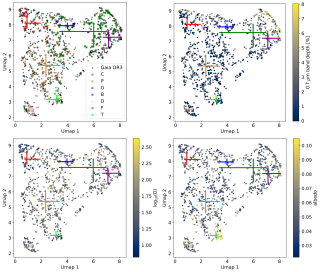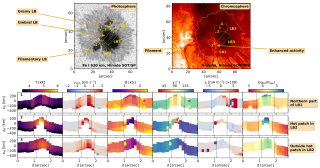It may interest you
-
 Despite the fundamental role that dark matter halos play in our theoretical understanding of galaxy formation and evolution, the interplay between galaxies and their host dark matter halos remains highly debated from an observational perspective. This lack of conclusive observational evidence ultimately arises from the inherent difficulty of reliably measuring dark matter (halo) properties. Based on detailed dynamical modeling of nearby galaxies, in this work we proposed a novel observational approach to quantify the potential effect that dark matter halos may have in modulating galaxyAdvertised on
Despite the fundamental role that dark matter halos play in our theoretical understanding of galaxy formation and evolution, the interplay between galaxies and their host dark matter halos remains highly debated from an observational perspective. This lack of conclusive observational evidence ultimately arises from the inherent difficulty of reliably measuring dark matter (halo) properties. Based on detailed dynamical modeling of nearby galaxies, in this work we proposed a novel observational approach to quantify the potential effect that dark matter halos may have in modulating galaxyAdvertised on -
 Asteroids are the remnants of the planetary formation in the Solar System and so, their study helps us to understand the conditions during the early stages of the formation of our planetary system. Among asteroids, those classified as primitives present similar spectra to that of carbonaceous chondrites, i.e., they are rich in carbon and organic compounds and silicates altered by the presence of liquid water (phyllosilicates). Primitive asteroids are well characterized in various wavelength regions, showing their most diagnostic feature at 3μm. However, there is a lack of information in theAdvertised on
Asteroids are the remnants of the planetary formation in the Solar System and so, their study helps us to understand the conditions during the early stages of the formation of our planetary system. Among asteroids, those classified as primitives present similar spectra to that of carbonaceous chondrites, i.e., they are rich in carbon and organic compounds and silicates altered by the presence of liquid water (phyllosilicates). Primitive asteroids are well characterized in various wavelength regions, showing their most diagnostic feature at 3μm. However, there is a lack of information in theAdvertised on -
 Light bridges are elongated and bright structures protruding into the umbra of sunspots. The presence of light bridges has a significant role in the evolution of sunspots and the heating of their overlying atmosphere. Therefore, investigating these structures is crucial to understanding fundamental aspects of sunspots. By applying a novel code based on deep-learning algorithms called SICON to spectropolarimetric observations acquired with the Hinode satellite, we computed atmospheric parameters that allowed us to infer the variation of the physical properties of light bridges on a geometricAdvertised on
Light bridges are elongated and bright structures protruding into the umbra of sunspots. The presence of light bridges has a significant role in the evolution of sunspots and the heating of their overlying atmosphere. Therefore, investigating these structures is crucial to understanding fundamental aspects of sunspots. By applying a novel code based on deep-learning algorithms called SICON to spectropolarimetric observations acquired with the Hinode satellite, we computed atmospheric parameters that allowed us to infer the variation of the physical properties of light bridges on a geometricAdvertised on